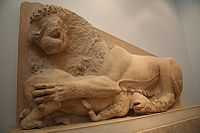Hekatompedon temple

The Hekatompedon or Hekatompedos, also known as Ur-Parthenon and H–Architecture, was an archaic temple on the Acropolis of Athens built from limestone, and was possibly placed in the position of the present Parthenon. The temple was built around 570–550 BC, during the rule of Peisistratos. Its foundations were discovered by the German archaeologist Wilhelm Dorpfeld.
It is identified by some archaeologists with the remains of a building in the southern part of the Mycenaean wall of Acropolis, a building which considered to be the ancient temple (in the place of the Mycenaean palace). The length of its crepidoma would have been c. 46 m. Many relics of the temple have survived such as the sculptures of the pediments, the famous "three-headed daemon", and the lions of limestone, exhibited in the Acropolis Museum. In the main temple was placed the wooden statue (from olive wood) of Athena Polias, and in the megaron (or opisthodomos) votives, the treasures, and material of the worship. There were coloured depictions on the metopes with scenes from the life of Heracles.
The temple was possibly dismantled in c. 500 BC to make place for the Older Parthenon.
References
- Manolis Korres, Topographic Issues of the Acropolis, Archaeology of the City of Athens; Retrieved 7 June 2012
- The Hekatompedon at the website of the Acropolis Museum ; Retrieved 7 June 2012
See also
- New Acropolis Museum
External links
| ||||||||||||||||
